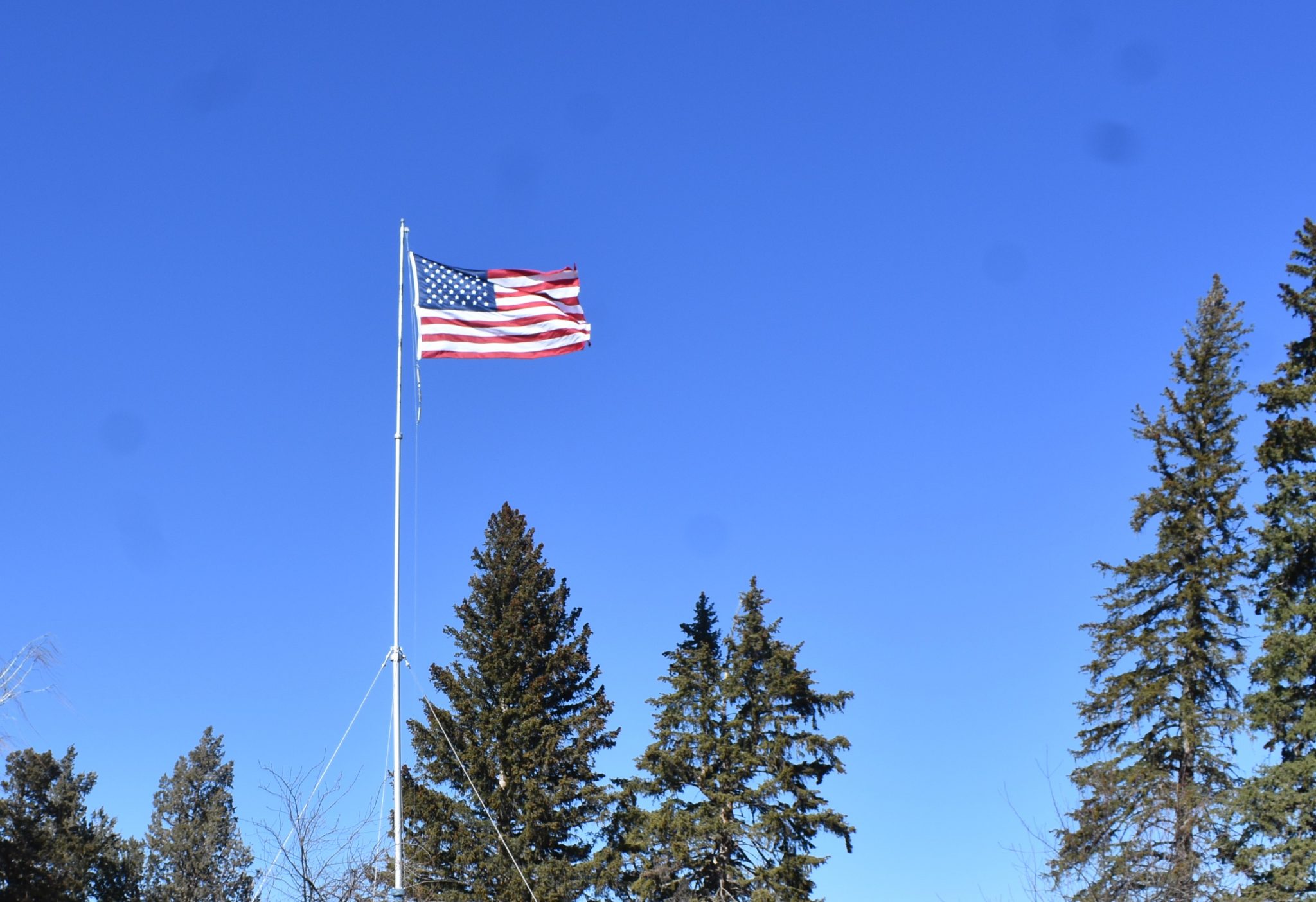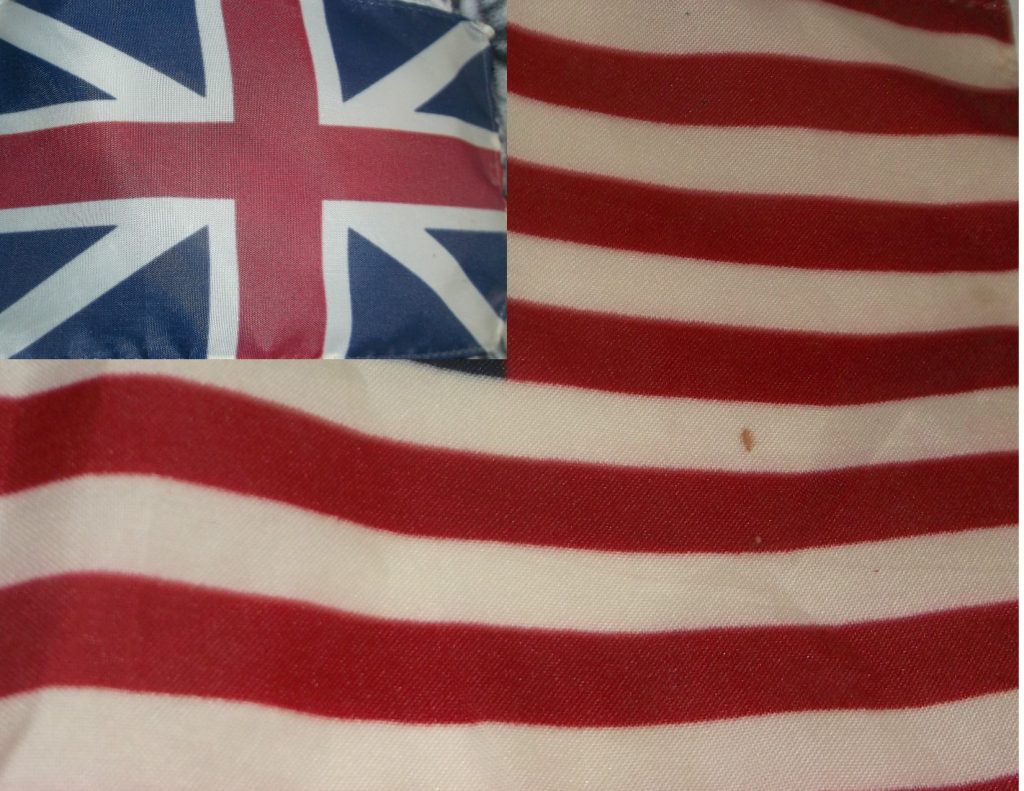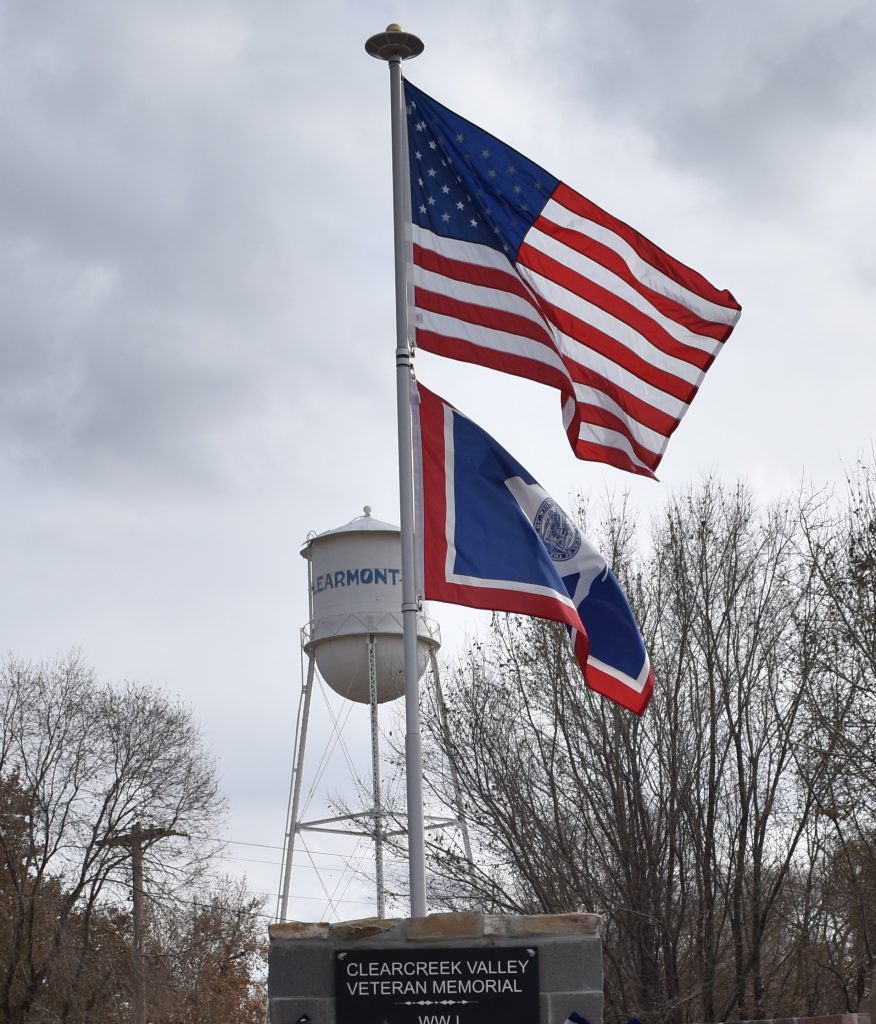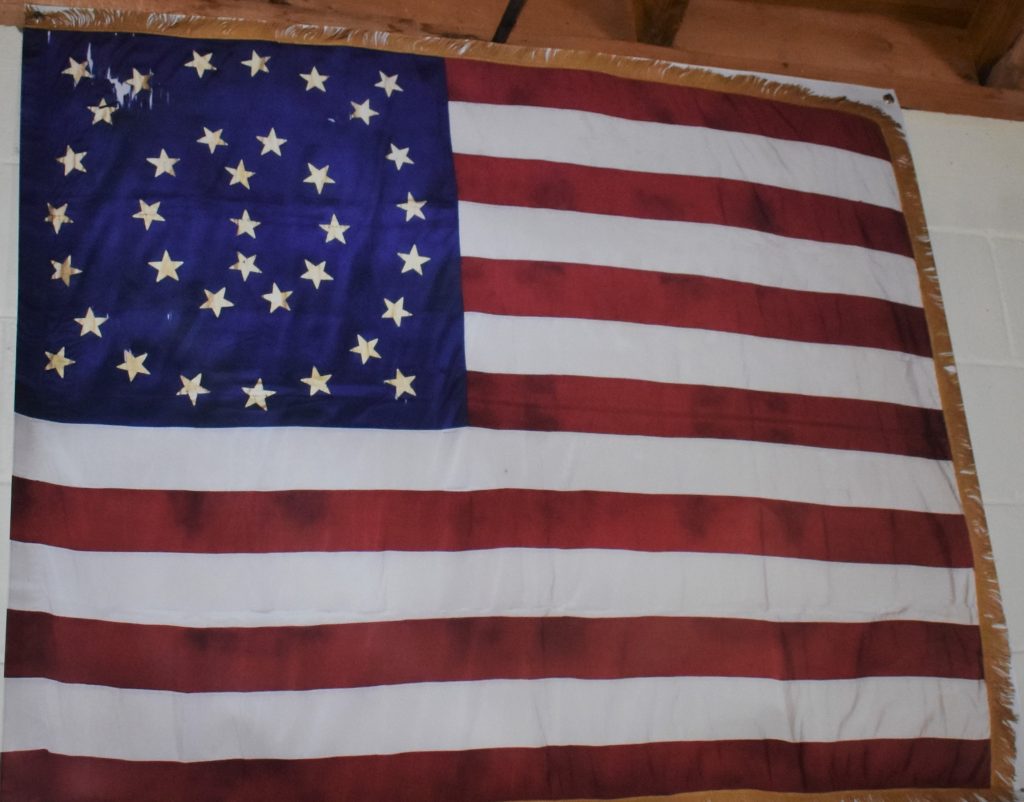News
Origins of Our Flag and Flag Day June 14

June 14th is Flag Day, a day that commemorates the adoption of the US flag, on June 14, 1777, by resolution of the Second Continental Congress.
Sheridan Enterprise on June 8, 1913 talks about the history of the flag. When the colonists first settled at Jamestown, and Plymouth, you remember, they did so under the flag of England, which consisted of a blue field bearing the white cross of St. Andrew and the red St. George Cross, as ordained by King James the First. Thus, you see, we have the red. white and blue which now appears in ‘Old Glory.’ From then on until the actual birth of the American flag the colonists—ln those stormy days preceding the Revolution — used the English flag with some changes here and there according to popular sentiment in the different colonies. And during this period, in which England’s flag seemed to be decidedly unpopular, some queer banners were unfurled to the breeze.
For example, in Massachusetts there was a white flag bearing a pine tree in its center and underneath it the motto, ‘An appeal to Heaven.” And down among the southern colonists a yellow flag in center of which appeared a rattlesnake, ready to strike, and the warning. ‘Don’t Tread On Me!’ was popular. “
As the revolution came on in 1776, there floated over Washington’s headquarters the English flag changed by white stripes across it’s red field. Although the origin of the stripes is not exactly known there is a theory that they were placed on the English flag to show that the colonies had separated from the mother county and the white stripes shall go down to posterity representing liberty.

One theory according to the above article, says the stars came from George Washington’s coat of arms, in which, “…appear three gold stars above two read bars on a white background,”, So, it is pleasant indeed to think that the red. the white with the stars and stripes were taken from the family standard of our first president
Centennial Post, Centennial, Wyoming, June 20, 1914 On June 14, 1777, the Continental Congress voted that the flag of the thirteen United States should consist of thirteen stripes, alternate red and white, the union being thirteen stars, white In a blue field, representing a new constellation. In 1794. Vermont and Kentucky having been admitted to the union, It was voted that a new stripe and a new star for each should be added. The apparent design was to continue this process of addition as new states came In. In 1818. however, Tennessee. Ohio, Louisiana, Indiana, and Mississippi having joined the union, with Illinois, Alabama, and Missouri knocking at the door, it was decided to alter the arrangement. In that year it was voted that the stripes should be thirteen only, recalling the “original thirteen,” while the union should have one star added to it with the admission of each new state the following Fourth of July being the date of addition in each instance. In that form the flag of the United . States, ‘ ‘Old Glory,” as it has lovingly been called, has become familiar to the people of all nations.

It might be interesting to speculate how big the flag would be today if they had continued to add stripes for each new state.
In 1916, President Woodrow Wilson officially established June 14 as National Flag day. Although it is not a national holiday, like Independence Day, many towns, people and businesses celebrate by flying flags in their yards, streets and on store fronts.
The Sheridan Enterprise, June 5, 1916 Flag Day. President Wilson has issued a proclamation calling on all American’s to observe Flag Day on June 14, with patriotic exercises. The presidents appeal certainly should be heeded. As he says, such an occasion gives opportunity for the expression of our ‘thoughtful love of America.
The flag of the republic is a symbol of its greatness the blessings it bestows and the wonderful opportunities if affords to all. To honor the flag and keep in mind what it means to uphold the nation. It is well that The boys and girls at all times should be instructed in patriotism of the right kind base on real love of country is the bulwark of the republic.
The governor each year proclaimed the day as ‘Flag Day’ and encouraged patriotic celebrations.

In The Sheridan Enterprise, June 7, 1918 – Star Spangled Banner to Be Sung in State at 10 o’clock on Morning of Day
CHEYENNE, Wyo., June 7—Governor Frank L. Houx has issued the annual Flag day proclamation, calling upon the citizens of the state to fittingly celebrate the 141st anniversary of the birth of the flag. The public is also urged to sing the Star Spangled Banner at 10 a. m., or 12 o’clock Washington time. This is part of an international movement to get Americans all over the world to sing the national anthem. The proclamation follows: “In this, perhaps the most momentous year in the history of our republic, it is fitting that the people of the United States should engage in an extraordinary observance of the anniversary of the adoption by the Continental Congress of the flag which is reverenced not only by us but by the inhabitants of every land where in the spirit of Christianity dominates the brutal instincts which are inherent to uncivilized and uncultured peoples.
“That the people of Wyoming may engage in concerted observation of this anniversary, I, Frank L. Houx, acting governor, designate Friday, June 14th, Flag day in this state, and call on the people of Wyoming on that day, individually and collectively to engage in public demonstrations of their love and reverence for the nation’s flag, and especially I suggest that at the hour of 12 o’clock noon, ‘Washington time, which will be 10 a.m., Wyoming time, all persons in the state halt whatsoever activities at the moment may be engaging them and repeat the inspired words of our national anthem, “The Star Spangled Banner.”
Schools and other association celebrated Flag Day with songs and patriotic ceremonies.
The Sheridan Enterprise, Volume 05, Number 102, June 12, 1914
PROGRAM FOR ElKS’ FLAG DAY EXERCISES The Elk Lodge has arranged an interesting programme for its Flag Day Anniversary exercises to be held held next Sunday afternoon, June 14th, 1914, at three o’clock at the Elks Home. The programme follows which surely will insure a large attendance as the public is cordially invited to attend :
PROGRAMME. Music— “War March” – Athalia, Mendelssohn Orchestra. Introductory Exercises, Exalted Ruler and Officers Invocation …Chaplain Song – – “Star Spangled Banner.” Elks’ Quartet. Flag Record – Capt. Scott K. Snively Altar Service – – Esquire and Officers Song— “Auld Lang Syne,” Officers and Members Elk’s Tribute to the Flag By a Brother Elk Flag Drill and Recitations – School Children Address – Hon. M. B. Camplin Overture— “America” – – Tobani Orchestra Song— “America” – (Audience to Join)
Lusk Herald June 6, 1912 JUNE 14, 1912 – marks the one hundred and thirty-fifth anniversary of the adoption by the Continental congress of the American flag. Today the stars and stripes, first designed by General George Washington and fashioned by the quaint Quakeress, Betsy Ross, floats over more than 3,500,000 square miles, including the United States, the Philippines, Alaska, Hawaii, the canal zone, Porto Rico, Guam and Samoa. More than 100,000,000 persons swear by it.
Flag day is not a national holiday, but it is observed in a large part of the Union, and the children of the public schools hold special exercises at this time.
Flag day was originated by George Belch, who had charge of a free kindergarten for the poor In New York. Exercises in honor of the flag were held by his pupils, and the press commented favorably upon the idea, which, through the aid of the Sons of the American Revolution, was adopted. Philadelphia, through the efforts of the Colonial Dames, arranged for the observance of Flag day at the same time.
NATIONAL ANTHEM As a part of the Flag Day exercises in the public schools there will be rendered many patriotic songs bearing upon the national emblem, some of which have a most interesting history. The oldest of these, “Hail, Columbia. Happy Land,” was written by Joseph Hopkinson in Philadelphia In 1798. The “Star Spangled Banner,” written by Francis Scott Key, is next in point of age. “America,” by Francis Smith, while not bearing upon the flag, is generally recognized as a national anthem. It was written in Andover, Mass., and was sung for the first time on the Fourth of July, 1832, by the school children of Boston. Francis Scott Key. during the war of 1812 watched the folds of old Glory ripple and sway over the walls of Fort McHenry until night and the mists shut out the inspiring sight. Knowing the persistency of the enemy and how small was the garrison at the fort, he sat through the night waiting and penned the words of the “Star Spangled Banner.” The flag which floated over the fort still exists having been kept by the fort’s defender, Charles Armistead, and preserved by his descendants.

There are rules for displaying the flag, as in The Northern Wyoming Herald, Cody, on May 23, 1917 RULES FOR FLAG ETIQUETTE Mrs. George B. McFarlane, chairman of the national committee of the Daughters of the Revolution “to prevent the desecration of the flag” has gleaned the following code or rules for flag etiquette from the army and navy usages and other sources, which she commends to the consideration of all Daughters of the American Revolution: 1. The flag should not be hoisted before sunrise, nor allowed to remain up after sunset. It should not be displayed on stormy days, nor left out overnight. 2. When the flag is displayed at half-staff, for mourning, it is to be lowered to that position from the top of the staff. It is afterward hoisted to the top before it is finally lowered…. 5. When the colors are passing on parade, or in review, the spectator should, if a man or boy, and if sitting rise, stand at attention and uncover (his head). 6. Whenever possible, the flag should be flown from a staff or mast but should not be fastened to the side of a building, platform or scaffolding….. 8. When the flag is used out of doors, it should always be allowed to fly in the breeze…. 10. For indoor decorations, the flag can only be used as a drapery and should never be placed below a person sitting. 11. When used on a bier or casket, at a funeral, the stars should be placed at the head. In no case should the flag be allowed to touch the ground…. 14. When “The Star Spangled Banner” is played all present should arise and stand at attention until the ending…. it should not be played as an exit march.
So, on Tuesday, June 14, 2022, people can demonstrate their love of flag and country by displaying Old Glory and remembering the many sacrifices that went into making the United States of America.


Earl P. Williams, Jr.
June 11, 2022 at 11:18 am
1. Scholars now credit Francis Hopkinson as the American flag’s designer. (Source: Leepson, Marc. “Flag: An American Biography.” St. Martin’s Griffin. 2005. p. 33.)
2. The Flag Manufacturers Association of America (FMAA) issued the following Tweet on February 4, 2021:
FMAA@FMAA_USA – Feb 4
#FlagFact: The designer of the American flag was Francis Hopkinson, a signer of the Declaration of Independence as a delegate from New Jersey.
FMAA_USA.COM
Submitted by Earl P. Williams, Jr., U.S. flag historian (paleovexillologist)